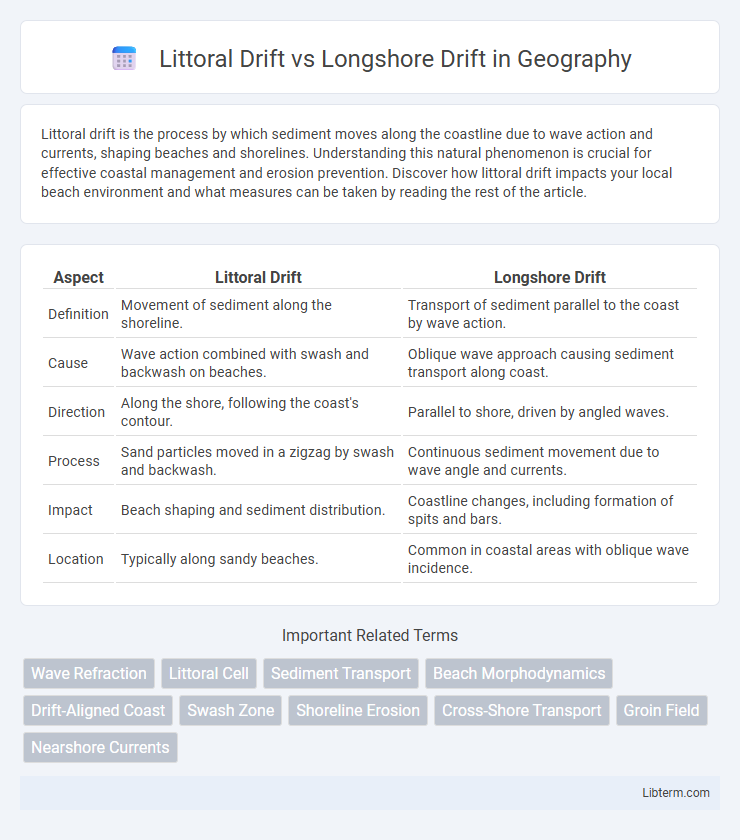Littoral drift is the process by which sediment moves along the coastline due to wave action and currents, shaping beaches and shorelines. Understanding this natural phenomenon is crucial for effective coastal management and erosion prevention. Discover how littoral drift impacts your local beach environment and what measures can be taken by reading the rest of the article.
Table of Comparison
| Aspect | Littoral Drift | Longshore Drift |
|---|---|---|
| Definition | Movement of sediment along the shoreline. | Transport of sediment parallel to the coast by wave action. |
| Cause | Wave action combined with swash and backwash on beaches. | Oblique wave approach causing sediment transport along coast. |
| Direction | Along the shore, following the coast's contour. | Parallel to shore, driven by angled waves. |
| Process | Sand particles moved in a zigzag by swash and backwash. | Continuous sediment movement due to wave angle and currents. |
| Impact | Beach shaping and sediment distribution. | Coastline changes, including formation of spits and bars. |
| Location | Typically along sandy beaches. | Common in coastal areas with oblique wave incidence. |
Introduction to Littoral Drift and Longshore Drift
Littoral drift and longshore drift refer to the movement of sediment along the coastline caused by wave action. Littoral drift encompasses both longshore drift, which moves sediments parallel to the shore due to oblique wave angles, and beach drift, which transports sediments along the beach face through swash and backwash. Understanding these processes is essential for coastal management, as they significantly influence shoreline erosion, deposition patterns, and the formation of coastal landforms.
Defining Littoral Drift
Littoral Drift refers to the combined movement of sediment along the shoreline caused by wave action and currents, shaping coastal landscapes through the continuous transport of sand and gravel. It encompasses both longshore drift, which specifically describes sediment movement parallel to the shore driven by oblique wave angles, and beach drift, caused by the swash and backwash of waves. Understanding littoral drift is essential for coastal management, as it influences erosion patterns, beach replenishment, and the stability of coastal structures.
Understanding Longshore Drift
Longshore drift is the movement of sediment along a coast by wave action, driven primarily by waves hitting the shore at an angle. It plays a crucial role in shaping coastlines by transporting sand and other materials parallel to the shoreline, influencing beach formation and erosion patterns. Unlike littoral drift, which includes both longshore and offshore sediment transport, longshore drift specifically refers to the sediment movement within the surf zone caused by oblique wave approach.
Key Differences Between Littoral and Longshore Drift
Littoral drift refers to the total sediment transport along the coastline, including both longshore drift and beach drift. Longshore drift specifically describes the movement of sand and sediment parallel to the shore caused by wave action at an angle. The key difference lies in scope: littoral drift encompasses all sediment transport along the shore, while longshore drift is the component driven directly by oblique wave energy.
Causes of Littoral and Longshore Drift
Littoral drift is caused by the combined action of waves approaching the shore at an angle and the subsequent movement of sediment along the coastline, driven by both the swash and backwash processes. Longshore drift specifically results from the oblique angle of wave approach that transports sand and sediment parallel to the shoreline through a zigzag motion. Both processes are influenced by prevailing wind directions, wave energy, and coastal morphology, shaping sediment distribution and coastal landforms.
Effects on Coastal Erosion and Deposition
Littoral drift and longshore drift both play crucial roles in shaping coastal erosion and deposition patterns by transporting sediment parallel to the shoreline. Littoral drift encompasses the combined processes of longshore drift and beach drift, redistributing sand and sediment along the beach, which can lead to the formation of spits, bars, and barrier islands. Longshore drift, driven by wave action at an angle to the coast, significantly influences erosion rates on one side of headlands and promotes deposition in sheltered bays, directly impacting coastal landforms and shoreline stability.
Measurement and Observation Techniques
Littoral drift and longshore drift are measured using sediment tracers, aerial photography, and GPS tracking to analyze sediment transport along coastlines. Coastal engineers employ sediment traps and shoreline surveys to quantify the volume and direction of moving sediments. Remote sensing technology and hydrodynamic modeling enhance observation accuracy by mapping wave energy and current patterns influencing drift processes.
Human Impact and Coastal Management
Littoral drift and longshore drift both describe sediment transportation along coastlines but differ in scale and specific processes affecting beach morphology. Human activities such as coastal construction, harbor development, and dredging disrupt these natural sediment flows, leading to increased erosion or accumulation in unintended areas. Effective coastal management integrates sediment budget analysis and implements engineered solutions like groynes and breakwaters to balance sediment dynamics and protect shorelines from adverse impacts.
Real-world Examples and Case Studies
Littoral drift and longshore drift describe sediment transport along coastlines but differ in mechanism and scale, with longshore drift driven by wave angle and littoral drift encompassing the total sediment movement. In the Mississippi Delta, longshore drift plays a crucial role in distributing sand and shaping barrier islands, illustrating the sediment transport's influence on coastal morphology. The Dutch coast provides a case study for littoral drift management, where engineered groynes and dunes strategically influence sediment flow to prevent erosion and protect infrastructure.
Conclusion: Importance in Coastal Geomorphology
Littoral drift and longshore drift are critical processes driving sediment transport along coastlines, shaping beach morphology and influencing shoreline stability. Understanding their dynamics helps predict erosion patterns and manage coastal environments effectively. These sediment transport mechanisms are essential in coastal geomorphology for maintaining habitat diversity and supporting sustainable coastal development.
Littoral Drift Infographic

 libterm.com
libterm.com